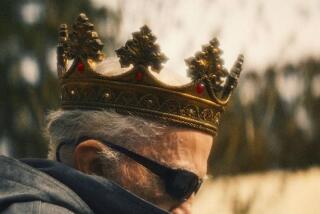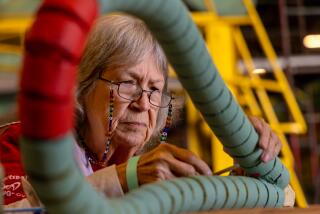ARTISANS / Spotlighting Makers of Handcrafted Goods : Crafting a Merrie Olde Spirit for Faire
- Share via
Mary Gullo of Garden Grove is the official basket maker of the Renaissance Pleasure Faire at Glen Helen Regional Park in Devore. Her handcrafted re-creations of baskets that were a staple of Elizabethan homes hang in her booth.
Gullo isn’t the only Orange County resident willing to make the trek to the fair in San Bernardino County, which runs every weekend until June 21. Several other Orange County residents--including a glassblower, a shoemaker and candlestick makers--set up booths every year to sell their wares and demonstrate their artistic talents.
“I have three distinct styles of baskets that I make,” Gullo said. “The English style that I sell at the fair and then the Native American and modern styles that I sell elsewhere. The fair strongly encourages artisans to sell and demonstrate the crafts that would have been found during the Renaissance times and, whenever possible, to use materials that would also have been available and used then.”
Gullo enjoys the opportunity to demonstrate her basket-weaving techniques and offers short classes on basket making at the fair.
“What I like about being at the fair is that it’s a family activity,” she said. “Parents are here with their children, and it’s a way that history can really come alive. Here, children see me at work, and it gives them a better understanding of what is involved in creating a basket.”
Gullo’s baskets range from rounded egg baskets (designed so eggs wouldn’t roll against one another and crack), flat herb and flower baskets (the English were great lovers of herbs for medicinal purposes, fragrances and other uses) and market baskets, which are long and wide to accommodate a loaf of bread and a slab of cheese. One of the most popular baskets she makes is what is now commonly referred to as a wall basket, with one flat and one rounded side.
“People hang them on the wall and place flowers in them,” Gullo said. “But their original purpose was to hold keys. During the Renaissance, the keys were huge. Keys indicated how wealthy you were, so a basket filled with keys was a symbol of affluence.”
Also at the fair, shoemaker Richard Baumann of Huntington Beach and owner of Wild Soles provides sandals and slippers to blister-weary customers.
“The most popular shoe I sell here is a sandal that’s actually a variation on an ancient Greek design. It’s laced across the top of the foot so it can be adjusted to fit anyone,” he said. “Obviously, these styles aren’t going to appeal to everyone, but some visitors use them as part of their costume, and others actually display them because the shoes are so different.”
Laguna Beach resident John Barber, a master glassblower, has kept a booth at the fair for 15 years.
“I spent several years in Europe learning all I could about glassblowing,” said the artist, who got his start in Bavaria. “When I returned to the United States, I set up a studio in Laguna Beach. At that time, there really weren’t many glassblowers around, so I had to build my own furnace and most of my own tools.”
For the Renaissance Faire, he makes a few thematic pieces.
Glass drinking horns are popular. The cone-shaped drinking vessels were commonly hung on the belts of Elizabethan men because the pointed ends made it impossible to set them upright. For the ladies, there are “bodice cups,” similar in style to the drinking horns, but with a more rounded bottom.
“It’s fun to do this show,” Barber said. “It also gives me a chance to display some of my newer works.”
For instance, Barber has recently begun combining oil painting with glassblowing. This technique calls for encasing the paint between two panes of clear glass, creating vivid swirls of color.
“They are more expensive,” Barber said, displaying a $450 urn. “However, people will stop by to purchase a $25 drinking horn or perfume bottle and see these. Then next year, they come by the booth and say, ‘I’ve been thinking about that vase all year.’
“It’s a way for me to display and educate customers about what processes are involved in glassblowing. I try to make all my pieces very expressive. People at the fair are very spontaneous, and it’s a lot of fun for me to talk to them,” he said.
At the entrance, Craig and JoAnn Canoy are selling their ceramic cups, bowls and candlestick holders. The Capistrano Beach residents have been a part of the fair for 21 years. In fact, they were the original candlestick makers.
“Candlestick holders have been our mainstay,” said Craig. “When we first started, we didn’t want to compete with all the other potters, so we concentrated on candlestick holders. However, we have expanded our collection to include other items as well.”
Craig throws all the pottery the couple sells, and JoAnn paints most of the designs on the candlestick holders.
“It’s fun being here,” she said. “What’s interesting for us is that in some cases we’re seeing the third generation of folks coming back here. People started coming with their children; now the children are grown and bringing back their youngsters.
“All the items we sell would have been found during the Renaissance. Some of the patterns and designs may be a little different, but the techniques of throwing the pots and goblets haven’t changed.”
There is one occupational hazard in working at the Faire, according to Innkeeper Terry Knisley of Huntington Beach, who presides over two afternoon feasts of ribs, Cornish game hens, vegetables, bread and honey butter and English trifle at the Faire’s Boarshead Inn.
Knisley says that it’s a struggle to return to the 20th Century when the weekend’s over.
“Mondays and Tuesdays are sometimes difficult,” he said with a laugh. “I have to be careful because I find myself answering the phone and saying, ‘Aye, milady.’
“I think what attracts people to the Renaissance Faire, whether they’re merchants or guests, is that this is an atmosphere completely different from what they normally experience,” Knisley said.


